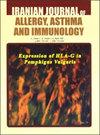Amygdalin Improves Allergic Asthma via the Thymic Stromal Lymphopoietin–dendritic Cell–OX40 Ligand Axis in a Mouse Model
IF 1.2
4区 医学
Q4 ALLERGY
Iranian journal of allergy, asthma, and immunology
Pub Date : 2023-11-07
DOI:10.18502/ijaai.v22i5.13993
引用次数: 0
Abstract
Asthma, characterized by persistent inflammation and increased sensitivity of the airway, is the most common chronic condition among children. Novel, safe, and reliable treatment strategies are the focus of current research on pediatric asthma. Amygdalin, mainly present in bitter almonds, has anti-inflammatory and immunoregulatory potential, but its effect on asthma remains uninvestigated. Here, the impact of amygdalin on the thymic stromal lymphopoietin (TSLP)–dendritic cell (DC)–OX40L axis was investigated. A BALB/c mouse model for allergic asthma was established using the ovalbumin-sensitization method. Amygdalin treatment was administered between days 21 and 27 of the protocol. Cell numbers and hematoxylin and eosin (H&E) staining in bronchoalveolar lavage fluid (BALF) were used to observe the impact of amygdalin on airway inflammation. TSLP, IL-4, IL-5, IL-13, and IFN-γ concentrations were determined via Enzyme-linked immunosorbent assay (ELISA). TSLP, GATA-3, and T-bet proteins were measured using western blotting. Cell-surface receptor expression on DCs (MHC II, CD80, and CD86) was assessed via flow cytometry. OX40L mRNA and protein levels were detected using western blotting and qRT-PCR, respectively. Amygdalin treatment attenuated airway inflammation decreased BALF TSLP levels, inhibited DC maturation, restrained TSLP-induced DC surface marker expression (MHCII, CD80, and CD86), and further decreased OX40L levels in activated DCs. This occurred together with decreased Th2 cytokine levels (IL-4, IL-5, and IL-13) and GATA3 expression, whereas Th1 cytokine (IFN-γ) levels and T-bet expression increased. Amygdalin thus regulates the Th1/Th2 balance through the TSLP–DC–OX40L axis to participate in inflammation development in the airways, providing a basis for potential allergic asthma treatments.小鼠模型中苦杏仁苷通过胸腺基质淋巴生成素-树突状细胞ox40配体轴改善过敏性哮喘
哮喘是儿童中最常见的慢性疾病,其特征是持续的炎症和气道敏感性增加。新颖、安全、可靠的治疗策略是当前儿童哮喘研究的重点。苦杏仁苷主要存在于苦杏仁中,具有抗炎和免疫调节潜能,但其对哮喘的作用尚未研究。本实验研究了苦杏仁苷对胸腺基质淋巴生成素(TSLP) -树突状细胞(DC) -OX40L轴的影响。
采用卵清蛋白致敏法建立BALB/c小鼠变应性哮喘模型。在方案的第21天至第27天之间给予苦杏仁苷治疗。采用支气管肺泡灌洗液(BALF)细胞计数及苏木精和伊红(H&E)染色观察苦杏仁苷对气道炎症的影响。采用酶联免疫吸附法(ELISA)测定TSLP、IL-4、IL-5、IL-13和IFN-γ浓度。western blotting检测TSLP、GATA-3和T-bet蛋白。流式细胞术检测dc细胞表面受体(MHC II、CD80和CD86)的表达。western blotting和qRT-PCR分别检测OX40L mRNA和蛋白水平。
苦杏仁苷治疗可减轻气道炎症,降低BALF TSLP水平,抑制DC成熟,抑制TSLP诱导的DC表面标志物(MHCII, CD80和CD86)表达,并进一步降低活化DC中的OX40L水平。与此同时,Th2细胞因子(IL-4、IL-5和IL-13)水平和GATA3表达降低,而Th1细胞因子(IFN-γ)水平和T-bet表达升高。
因此,苦杏仁苷通过TSLP-DC-OX40L轴调控Th1/Th2平衡,参与气道炎症的发展,为潜在的过敏性哮喘治疗提供基础。
本文章由计算机程序翻译,如有差异,请以英文原文为准。
求助全文
约1分钟内获得全文
求助全文
来源期刊
CiteScore
2.60
自引率
6.70%
发文量
64
审稿时长
>12 weeks
期刊介绍:
The Iranian Journal of Allergy, Asthma and Immunology (IJAAI), an international peer-reviewed scientific and research journal, seeks to publish original papers, selected review articles, case-based reviews, and other articles of special interest related to the fields of asthma, allergy and immunology. The journal is an official publication of the Iranian Society of Asthma and Allergy (ISAA), which is supported by the Immunology, Asthma and Allergy Research Institute (IAARI) and published by Tehran University of Medical Sciences (TUMS). The journal seeks to provide its readers with the highest quality materials published through a process of careful peer reviews and editorial comments. All papers are published in English.

 求助内容:
求助内容: 应助结果提醒方式:
应助结果提醒方式:


